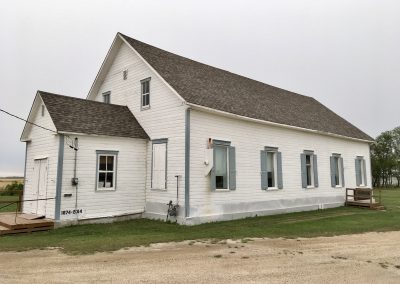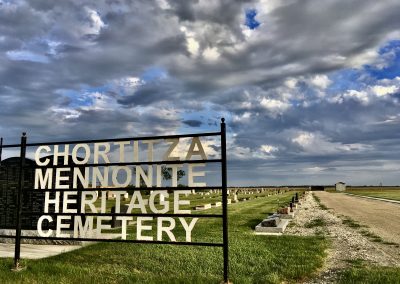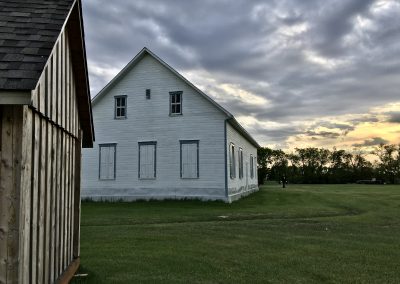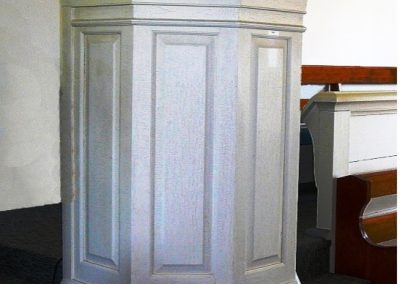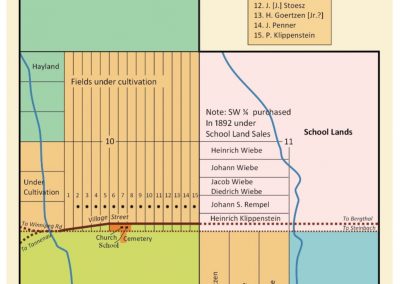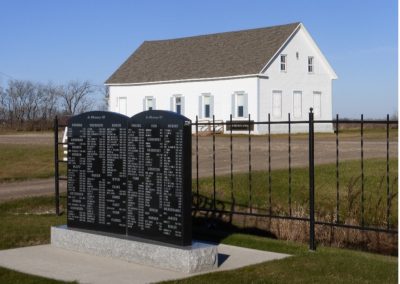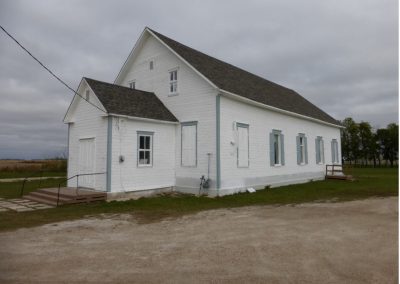Chortitz Church & Cemetery
Chortitz
Waypoint Info
Lat Long
(49.546281, -96.830509)
GPS Coordinates
49° 32′ 46.6116” N
96° 49′ 49.8324” W
Next Waypoint (East)
Rosenthal Nature Park
Previous Waypoint (West)
Gruenfeld
History of the site
This church stands on the site of the original first Mennonite church building constructed on the East Reserve in 1877. It was replaced in 1896-7 by the current building. The designer was Gerhard Schroeder and the builder was John Neufeld. It stood on the south side of the village street which ran parallel to what is now municipal road 37N. All residences lay on the north side of the street, and just so the south over the road allowance was the cemetery, with the headstone of the man most influential in bringing the Mennonites to Manitoba from Ukraine in the 1870s (then “South Russia”), Bishop Gerhard Wiebe. Although all the members of this group were from the Bergthal Colony and not the Chortitz Colony, the name taken here was in recognition of the fact it was the home village of Bishop (Ältester).
Church services were conducted in German, and men and women were seated on either side of a central aisle. There was no Sunday School. Women wore hats in church; men did not. Music was led by four men without musical accompaniment. Singing was done from a hymnal without notes.
Chortitz was the hub of the East Reserve, with the only Bergthaler church, a school, an early post office in 1884, municipal office, general store, telephone exchange, and a bank. The departure of many Mennonites for Paraguay in the 1920s negatively impacted the village, but it continued to function as a small service centre until the store burned down and the school closed in the 1960s. In 1967 the name of the post office changed to Randolph, which was the name of the district school established by the Department of Education in 1919.
Transformation
This house of worship hosted a congregation until 2010, at which point it was decommissioned by the Chortitzer Mennonite Conference (now Christian Mennonite Conference). In 2014 it was declared a Municipal Heritage Site by the RM of Hanover.
What you see today
Today the Chortitz Heritage Church Committee administers the site on behalf of the RM of Hanover, hosting special events and encouraging people to use the church for weddings and funerals and other special events.
On the church site you will find a shelter with guestbook and benches where you can rest in the shade. On the historic cemetery site you will find composting toilet facilities.
The village of Randolph (formerly Chortitz) no longer offers any amenities, though if you are lucky the Randolph Garage may be open and a peek inside would be most enjoyable and enlightening.
Chortitz – origin of the name:
Chortitz, pronounced Gor’-tiets by Mennonites, is named after the first colony in “New Russia”, now Ukraine, settled in 1789 by Mennonites from Poland/Prussia. The name Chortitz is a western spelling of the name Khortytsa or Khortytsya as the island in the Dnieper River was called from ancient times, when it was used for hundreds of years by semi-nomadic peoples of Eastern Europe as a place of worship, trade and diplomacy. The word itself has its roots in the name of a pagan god Khors to whom sacrifices were made as late as the middle of the 10th century according to Byzantine Emperor Constantine VII [Olga Apanovich: Khortitsya (Mistetvo Publishers, Kyiv, 1968), p. 1]. These sacrifices were made on the island of Khortitza where an altar to Khors, a sun god, had been built by the ancients and honoured until what is now Ukraine was officially Christianized in 988 A.D. The Khortytsa region was an estate acquired by Grigory Potemkin after the defeat of the Cossacks in 1775. In 1789 Potemkin adroitly exchanged his own Khortytsa estate for the more promising government land the Mennonite delegates had chosen farther south near Berislav.
One of the early Khortytsa villages took the ancient name for itself, and that was repeated in Manitoba where one of the very first villages established on the Mennonite East Reserve in 1874 was Chortitz. One of the mythic features of the original Chortitz village in Ukraine was the existence of a huge oak, already many hundreds of years old when the Mennonites arrived. Today an acorn from that tree has grown into a large specimen in Winnipeg, and an acorn from that tree has grown into a small oak tree on the site of this early church in the centre of Chortitz in Manitoba as well.
The Mennonite village of Chortitz in Manitoba served as a meeting place for early settlers from the Bergthal and Chortitz Colonies in Ukraine. The first and most influential church building on the East Reserve was built in this village in about 1877 since this is where the religious leader, Elder Gerhard Wiebe, lived and the name carried over into the official name of one denomination of Mennonites, the Chortitzer Mennonite Church, which is today the Christian Mennonite Conference. The name Chortitz continued to be used wherever Russian Mennonites settled, so that today there is also a Chortitz in the WR, in Saskatchewan, in Mexico, in Paraguay, and in various parts of Russia.
The church building seen here today was built in 1896-97 on the same site as the original one, and commissioned in fall of 1897. The architect was Gerhard Schroeder (1848-1910). His unique rafter design allowed for a wide suspended ceiling without the massive pillars normally found in the aisles of old Mennonite churches. The building was in continuous use by the denomination until 2010 when a huge homecoming was held on August 29, during which the building was decommissioned by the Chortitzer Conference. The church building was then offered to the Mennonite Heritage Village Museum but since the Museum already had two churches, there was little incentive to add another. Consequently, the site was put up for sale but a group of interested individuals appealed to Conference to transfer the title to the Rural Municipality of Hanover for a provisional 5-year period during which a long-range plan for its preservation as a heritage site could be undertaken, and repairs be made. A plan to involve the Conference, the Mennonite Heritage Village and the RM of Hanover was developed, with the idea that the site has significance to all three organizations. In the meantime, an organizational meeting was convened in January of 2012 to formalize the support group as the Chortitz Church Heritage Committee [later Chortitz Heritage Church Committee]. Ownership was transferred to the RM of Hanover in June 2013. By virtue of Bylaw 2333-13, the RM of Hanover designated the site as a Municipal Heritage Site in January, 2014, and in 2018 at the end of the 5-year period a Memorandum of Understanding reached with the RM of Hanover which saw the title remain with the Municipality, but stipulating that the agreement be reviewed every five years, and the regular affairs of the site be in the care of the CHC Committee.
Originally the village street ran to the north of the building, since there was no surveyed government road, and therefore the cemetery was just to the south of the building. Today the section road runs between the church and the cemetery, which is still active. A close look at the neighbouring yards will reveal a slight hump where the village street used to be. The arrangement in the church sanctuary originally had the pulpit and raised podium for the ministers and song leaders along the side wall, with separate entrances for the men and women, who also sat in separate sections in the sanctuary. Later a 90-degree turn placed the front at the east end of the building.
Events are still held about twice a year, featuring acapella singing in German. The building is also available for weddings, funerals, special prayer vigils, or other more regular rentals.
Pioneers of Chortitz, East Reserve
The village of CHORTITZ was situated just north of the road allowance of Road 37N, along the south edge of the southeast quarter of section 10-7-5E. The village main street ran parallel to Road 37N but some distance north of the current church building, since the government road that today runs south of the church building did not exist at the time. All the residences were north of the main village street but the church, school, and the cemetery were south of the street which was community pasture to be shared by all the villagers. Mennonites from three parts of southern Russia (today Ukraine) arrived on the Mennonite East Reserve beginning in 1874: Old Colony settlers with roots in Chortitza, Kleine Gemeinde settlers with roots in the Molotschna from Borosenko, and Bergthaler settlers from the Bergthal Colony.
Most of the homestead applications for the village of Chortitz were registered in August and September of 1874 and the village was founded the same year. About ten of the original settlers were an anomaly on the East Reserve, in that they originated in the old colony of Chortitza, but had moved to Borosenko ten years earlier, and now arrived on the first ship with the other Mennonites from Borosenko, the Kleine Gemeinde who settled in their own villages. It is likely that the Chortitza families named the village in honour of their ancestral home in Russia. Almost all of these Chortitza settlers left the East Reserve for either the West Reserve or the Dakotas by 1881, leaving the village to the Bergthal settlers who took up the canceled homestead applications. It is very difficult to ascertain exactly who was included in the original village catchment area, since other village lands surrounded this one, and often settlers are listed under one village and a few years later the same settler is given under a different village. However, in 1877 Chortitz was one of very few villages that registered a village agreement with the government, and therefore a definitive list exists as of that year. That agreement was signed by seven of the original settlers of Chortitza background and by eight settlers of Bergthaler background. Clauses in the agreement prohibited the landowners from mortgaging, leasing, encumbering or selling their property to anyone other than a Mennonite, and then only with the written consent of the other signatories. It also specified that the southwest and southeast quarters of section ten in Township seven Range five east of the principal meridian be designated as the village site (although in fact the village already existed there by 1877). Each lot in the village was to have a frontage of 231 feet, and a depth of 247.5 feet on which the buildings and gardens were to be situated. (Source: Orlando Hiebert: Working Papers of the East Reserve Village Histories.)
By the time the agreement was made, several of the original settlers had left:
- Peter and Maria (Buhr) Friesen who arrived in 1874 and filed an entry on sw 3-7-5E, but left within a year for Cass County, USA.
- Heinrich and Elisabeth (Penner) Unruh/Unrau arrived in 1874 and filed an entry on ne 3-7-5E, but Heinrich died within a year and Elisabeth remarried and moved to the West Reserve with her second husband.
- Johann and Anna (Olfert) Neudorf arrived in 1874 and filed an entry on se 22-7-5E but Johann died in May of 1877 and Anna remarried and moved to the West Reserve with her second husband, although she obtained a patent on the homestead in 1882.
- David and Agatha (Friesen) Pauls arrived in 1874 and filed an entry on ne 27-7-5E but by the fall of 1875 they had canceled their homestead application and moved to Cass County, USA.
- David and Maria (Neufeld) DeFehr arrived with the same group in 1874 and filed an entry on ne 34-6-5E but became affiliated with Rosengart by 1881 census.
Signatories to the Village Agreement 1877
- Johann Nickel b. 1852 ne 15-7-5 (Maria Quiring b. 1853)*
- Peter Esau b. 1832 se 15-7-5 (Maria Braun b. 1835)*
- Heinrich Goertzen Jr. b. 1836 sw 15-7-5 (Helena Doerksen b. 1838)
- Wilhelm Vogt b. 1843 ne 10-7-5 (Anna Quiring b. 1845)*
- Gerhard Wiebe b. 1827 (Bishop) se 10-7-5 (Elisabeth Dyck b. 1828)
- Abraham Klassen b. 1849 nw 10-7-5 (Barbara Quiring b. 1851)*
- Johann Quiring b. 1836 sw 10-7-5 (Anganetha Wiebe b. 1837)*
- Isaak Braun b. 1844 ne 3-7-5 (Maria Doerksen b. 1843)*
- Heinrich Klippenstein b. 1850 se 3-7-5 (Katharina Mueller b. 1854)
- Peter Redekopp b. 1846 nw 3-7-5 (Anna Doerksen b. 1849)*
- Johann Wiebe b. 1853 sw 3-7-5 (Barbara Peters b. 1853) – son of Bishop
- Peter Wiebe b. 1841 nw 2-7-5 (Judith Penner b. 1842)
- Jacob Penner b. 1834 sw 2-7-5 (Maria Doerksen b. 1840)
- Heinrich Wiebe b. 1859 nw 34-6-5 (Maria Peters Wiebe b. 1855) – son of Bishop
- Johann Wiebe b. 1829 nw 35-6-5 (Anna Penner b. 1834)**
Of these signatories, by the 1881 census the seven Old Colony families (*) and one Bergthaler family (**) had moved to Edenburg, West Reserve. The village had 15 lots, of which about 14 were usually occupied as indicated by the periodic Federal Census. Note that many of these families are related.
Note: Peter Redekopp was the man who rescued the two men in the well cave-in at the Shantz sheds upon arrival in August 1874.
This pulpit design is virtually identical to that of the Mennonite churches in Prussia, and may have similarities to the ones in the Netherlands even earlier.
Emigrations from Chortitz
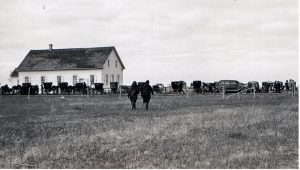
1926: Several families from Chortitz emigrated to the Gran Chaco in Paraguay over the School Question. The meetings about the emigration were often held in this church as seen above.
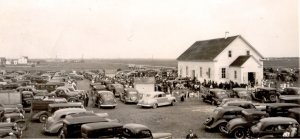
1948: meetings were held in the Chortitz church after WWII again about emigrating to Paraguay, now to East Paraguay, an area with lush jungle-like vegetation in contrast to the arid Chaco where the 1926-7 Mennonites settled.

